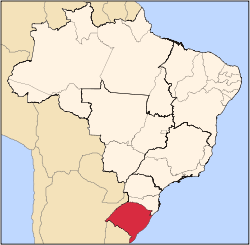Horizontina
Horizontina (Portuguese pronunciation: [oɾizõˈtʃĩnɐ]) is a municipality and a city in Rio Grande do Sul, in southern Brazil, with 19,174 inhabitants in 2014. Is located 496 km north of the state capital. The first settlers were German, Italian and Polish immigrants who arrived in the region in 1927, though the city was created only in 1955. Nowadays, most of the inhabitants are of German-Brazilian descent.
Horizontina | |
|---|---|
 Flag  Seal | |
 Horizontina Location in Brazil | |
| Coordinates: 27°37′33″S 54°18′28″W | |
| Country | |
| Region | South |
| State | Rio Grande do Sul |
| Founded | February, 28th 1955 |
| Government | |
| • Mayor | Nildo Hickmann |
| Area | |
| • Total | 232,476 km2 (89,759 sq mi) |
| Elevation | 343 m (1,125 ft) |
| Population (2014) | |
| • Total | 19,174 |
| • Density | 0.082/km2 (0.21/sq mi) |
| Time zone | UTC3 |
| Website | http://www.horizontina.rs.gov.br/ |
Supermodel Gisele Bündchen was born and raised in Horizontina.
The city has an average annual temperature of 20.8 °C. With 79.4% of the population living in the urban area, the city counted in 2009 with eleven healthcare facilities. Its Human Development Index (HDI) is 0.783, considered high by the United Nations Development Programme (UNDP), and the 11th largest in the Rio Grande do Sul state, the 110th of Brazil and the first of its micro-region.
The colonization of the city occurred in 1927, when the first German colonists arrived in the region. A year later came more families from other ethnic groups, causing the place to develop. The first name of the city council was Belo Horizonte, later becoming Vila Horizonte, Horizonte and the current name, Horizontina, in 1944. Before being elevated to a municipality, it was a district in the municipality of Santa Rosa. Only in December 1954 the district was emancipated.
The city is known as the "Cradle of National Harvesters Automotive", due to construction of the first Brazilian automotive harvester in the city in 1965. Even today, a unit of US company John Deere is installed in Horizontina, generating about 80% of all tax revenues of the city.
Regional language
The German dialect Riograndenser Hunsrückisch is a regional language and as such an integral part of the history of many municipalities throughout the state of Rio Grande do Sul since pioneer days, including Horizontina. The dialect is spoken by millions of people in the state of Rio Grande do Sul, it is also part of the history of Horizontina and the state's northwest region. In 2012 the Legislative Assembly voted unanimously in favor of official recognition of Riograndenser Hunsrückisch, the German dialect more spoken in Brazil, and with the highest concentration of speakers in Rio Grande do Sul, as part of the intangible cultural heritage to be preserved and protected.
